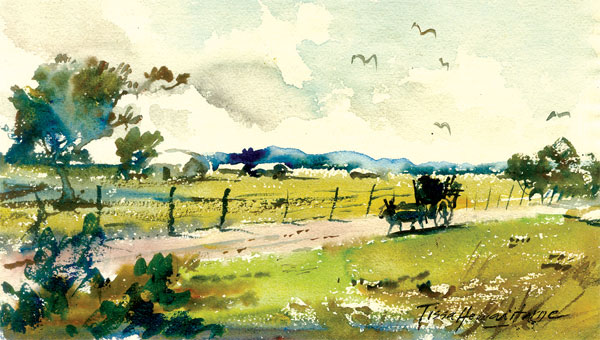|
Learn to draw by Tissa Hewavitarane:
Techniques for landscape
There are many techniques that normally can be used to alter the
surface of watercolour. One of the most usual tools in the studio of a
watercolourist is the hairdryer. This can speed up the water evaporation
from the paper. Another method that can modify the surface of the paper
is sand paper. Watercolour on dry and wet backgrounds is the most
spontaneous and exciting combined in one painting which provides a whole
armoury of textural contrasts.

When the surface is wet the paint spreads. On a dry surface, on the
contrary, the brush strokes can be controlled.
These techniques facilitate the realisation of all kinds of
landscapes, although what is important is to use the correct technique
at the correct time and place.
If these two techniques are used together with certain ability this
can pay dividends for the landscape painted, or trees, reflections, or
atmosphre in the background of the picture.
To do a wash, dip the brush in water and load it well before touching
a little colour with the tip on the palette. Next pull it across the
surface, exercising some pressure so that the water is released. Move
the colour in the water to dissolve and make a foreground mix. Drain the
brush; there must not be too much water. Use the wash to colour the area
destined to be the top. The brush strokes have to be uniform and cover
all areas of the picture.
In general a background of a landscape like the sky or water are
painted on wet paper. On this surface tone gradation and merging of
colour can be done which show well the luminosity and atmosphere of the
landscape. On the background tone gets dried and different effects are
realised to paint trees and reflections.
When painting the sky, the paper is damped with a sponge, in this way
you avoid soaked areas appearing on the surface. On wet paper starting
from the top, the wash is applied. The brush does its part by spreading
the colour from above in strokes that cover the whole area of the sky.
Observe the painting I have done, it is a village scene in open land.
The tree at the left corner by the side of the hut with dark tones
makes the sunlit areas sparkle through contrast. The composition
presented by nature is excellent. I have introduced a bullock cart to
bring depth, making it a more balanced picture. The whole scene has
captured the glare of the warm sunshine in a village.
One who expresses himself in the medium of watercolour must know the
objects he needs to express, before the brush strokes touch the paper. |

